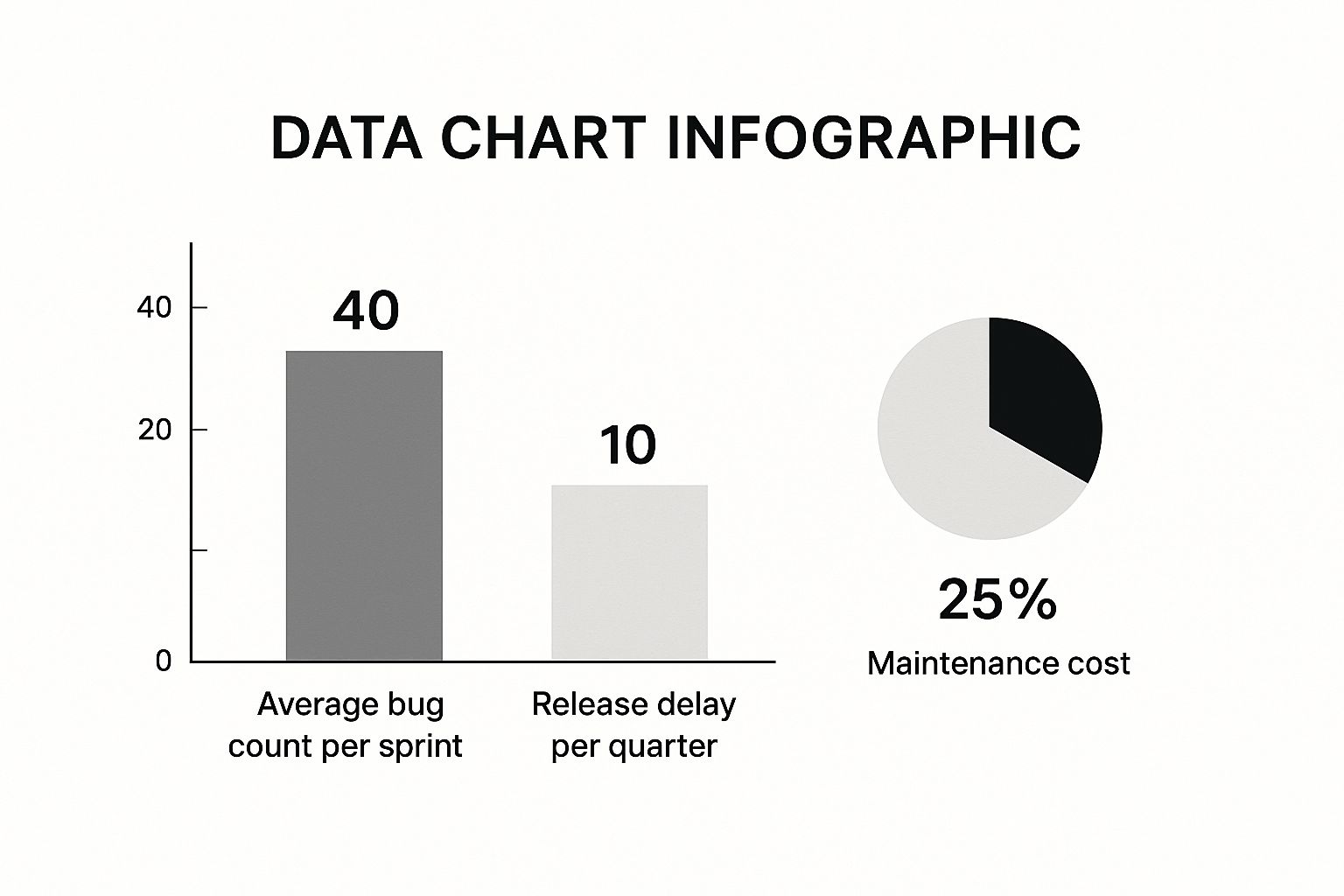managing technical debt
code quality
software maintenance
development strategy
legacy systems
Managing Technical Debt: Strategies for Clean, Profitable Code
The Hidden Cost of Technical Debt Nobody Talks About
Let's talk about technical debt. Everyone fixates on the messy code, the bugs, the performance hits. But I've seen technical debt nearly destroy a $50 million startup, and I can tell you the real cost is much bigger. It's about survival. It's about the slow but steady destruction of team morale, lost chances in the market, and the creeping dread of deploying anything.
I've talked to CTOs who've stared into the abyss of a codebase held together by hope and virtual duct tape. They all describe a similar, chilling pattern. That "quick win" from a few months ago? It's now eating up 40% of their team's productivity. Essential new features, the ones they need to stay competitive, get delayed for weeks, then months. The team, once excited and innovative, becomes demoralized, constantly battling the ever-growing monster of technical debt.
Quantifying the Unseen Damage
How do you actually measure this damage? It's more than just counting lost developer hours. You have to consider the ripple effect:
-
Lost Revenue: Every delayed feature is potential revenue lost. Imagine a crucial e-commerce update delayed by a month because of tangled, difficult code. The lost sales can be devastating.
-
Increased Support Costs: A buggy product frustrates customers. This means a flood of support tickets and puts a huge strain on your support team’s resources.
-
Erosion of Team Morale: Constantly wrestling with technical debt leads to burnout and resentment. Your best developers might even leave to avoid the constant firefighting.
To give you an idea of the scale of this problem, over the last decade, technical debt has become a trillion-dollar issue for the world's biggest companies. In 2025, Global 2000 companies are projected to be dealing with roughly $2 trillion in accumulated technical debt—an amount comparable to the GDP of many mid-sized countries. Discover more insights
Let's put some real numbers to this hidden cost. Take a look at the impact on different sized organizations:
To understand the true cost of technical debt, let's examine how it impacts businesses of different sizes. The following table breaks down the annual costs, developer hours lost, and the subsequent impact on development velocity.
Technical Debt Cost Breakdown by Organization Size
| Company Size | Lines of Code | Annual Debt Cost | Developer Hours Lost | Impact on Velocity |
|---|---|---|---|---|
| Small Startup (10-50 employees) | 100,000 | $50,000 - $250,000 | 2,000 - 10,000 | 10-20% reduction |
| Medium-Sized Company (50-250 employees) | 500,000 | $250,000 - $1.25 million | 10,000 - 50,000 | 20-30% reduction |
| Large Enterprise (250+ employees) | 1 million+ | $1 million+ | 40,000+ | 30-40% reduction |
This table provides estimated figures for illustrative purposes. Actual costs can vary significantly depending on several factors.
As you can see, neglecting technical debt can have a significant impact on a company's bottom line and its ability to deliver new features quickly.
Communicating the Cost in Business Terms
Many CTOs struggle to convey the urgency of managing technical debt to executives focused on the bottom line. The trick is to translate code issues into budget impact. Don’t talk about refactoring, talk about reducing support costs by 20%. Don’t focus on code quality, emphasize how addressing technical debt can speed up feature releases and help win market share. Need a deeper dive on managing technical debt effectively? Check out this comprehensive guide: Managing Technical Debt: Strategies to Save Costs & Innovate. For those interested in boosting database performance, this might be helpful: database performance optimization.
In the end, managing technical debt isn’t just about cleaner code; it's about creating a business that can thrive long-term. It's an investment in your team's future, protecting your revenue, and making sure your product can adapt and succeed in a competitive market. Ignoring the hidden costs of technical debt is a risk no business can afford.
Reading the Warning Signs Before Your Codebase Implodes
Last month, I was chatting with a developer who told me their deployments took six agonizing hours. The reason? Everyone was terrified of breaking something. Sound familiar? It's a classic sign of a codebase buckling under the pressure of technical debt. Let's explore the subtle hints and screaming alarms that tell you debt is choking your development process.
From Code Smells to Performance Plummets
Spotting the indicators of technical debt is the first step towards getting it under control. These can range from those subtle "code smells" that make experienced developers question their life choices, to blatant performance issues that lay bare the sorry state of your system.
-
Deployment Dread: Super long or complicated deployments, fear of releasing updates, and a ton of manual steps are all huge red flags. These usually point to brittle, tightly coupled code – change one thing and who knows what’ll break.
-
Bug Bonanza: A sudden influx of bugs, especially regressions (fixing one bug creates another), often means there are deeper structural issues in your code. It's like plugging holes in a dam – fix one, and another one pops up.
-
Performance Problems: Slow loading times, unresponsive interfaces, and constant timeouts often scream accumulated technical debt. This might be down to inefficient algorithms, a poorly designed database, or simply a lack of optimization.
-
Code Smells (and Screams): Duplicated code, ridiculously long methods, and tangled logic might seem small, but they’re often symptoms of deeper structural issues. These are the canary in the coal mine – ignore them at your peril.
Monitoring Debt Accumulation: Don't Just React, Anticipate
Catching technical debt early is key. This means setting up monitoring that goes beyond basic error tracking. It’s like managing your finances – you don't just react to an overdraft; you track your spending to prevent it. Track things like code complexity, code churn (how often code changes), and the number of "TODO" comments. These are your early warning signals. For example, a module with constant high code churn and a growing list of "TODOs" is begging for a refactor. A study by Sonar analyzed over 200 software projects in a single year and found some scary numbers. For a typical project with one million lines of code, technical debt costs about $306,000 annually, or roughly 5,500 developer hours spent on fixing things. Check out the research here.

Establishing Health Checks: Keeping Your Codebase Breathing
Just like regular health checkups are vital for you, regular codebase health checks are essential. This means periodically reviewing code quality, running performance benchmarks, and conducting security scans. Consider these your system’s vital signs. They can give you valuable insights into problem areas, helping you address potential debt before it becomes a crisis. Also, train your team to recognize and deal with debt patterns during everyday development. Empower them to fix small issues as they come up, stopping them from snowballing into bigger, more complex messes. This could be through pair programming, code reviews, or simply encouraging developers to own their code.
By learning to spot these warning signs and putting proactive monitoring and health checks in place, you can wrestle control of your technical debt and build a healthier, more sustainable codebase. This not only makes your development process more efficient, but it also protects the long-term health of your software projects.
Making Smart Choices About What to Fix First
Let's be honest, not all technical debt is created equal. Some debt can hide in your codebase like a quiet gremlin, causing no real trouble for years. Other debt, however, is more like a monster in the closet, actively sabotaging your project and keeping you up at night. The trick to effectively managing this debt is knowing which monster to fight now and which gremlin you can just keep an eye on. This is where prioritization comes in.
Prioritizing Technical Debt: A Practical Approach
Teams that consistently ship quality software don’t just randomly fix technical debt; they use frameworks and strategies that hold up even under pressure. It's a bit like triage in a hospital emergency room. You need to address the most critical patients first. A popular method is the Technical Debt Quadrant, which categorizes debt by intent (was it deliberate or accidental?) and prudence (was it a reckless decision or a prudent one?). This helps separate the acceptable, calculated debt you took on strategically from the debt that's a result of cutting corners or just plain bad code. Another practical framework is the Impact/Effort Matrix. This one zeroes in on two crucial factors: how much the debt is impacting your business and how much effort it will take to fix it.
The Impact/Effort Matrix: Your Prioritization Tool
The Impact/Effort Matrix is a great way to visualize and prioritize your technical debt. Imagine plotting each item of debt on a graph. Impact is on one axis, effort is on the other. Suddenly, the “low-hanging fruit” becomes crystal clear – those high-impact problems that are relatively easy to fix. These are your quick wins, the places where you get the biggest bang for your buck.
Here’s a simple visualization:

This infographic paints a stark picture of what happens when you let technical debt run wild. With an average of 40 bugs per sprint, release delays of 10 days per quarter, and maintenance costs eating up 25% of the project budget, the need for effective debt management couldn't be clearer. These numbers really highlight why strategic prioritization is so essential to minimizing negative impacts.
Let's break down how the Impact/Effort Matrix helps you prioritize in practice:
- High Impact, Low Effort: Fix these immediately. Think of a critical bug causing crashes. High impact on your users, but often a relatively quick fix. Get it done!
- High Impact, High Effort: These are the big ones. They require careful planning and probably a dedicated team. Imagine rewriting a core system. Huge impact, but also a substantial effort. Break these down into smaller, manageable chunks.
- Low Impact, Low Effort: Address these when you have a chance. Maybe a minor code style inconsistency. Low impact, easy to fix while you’re already working in that part of the codebase.
- Low Impact, High Effort: Honestly, defer these or ask yourself if they’re really worth fixing. An outdated library in a rarely used module might fall into this category. Your time is precious.
Before we move on, let's look at a handy tool to help you prioritize:
To help you put this into action, here’s a simple prioritization matrix you can use:
Technical Debt Prioritization Matrix
| Debt Category | Business Impact | Fix Complexity | Priority Level | Recommended Timeline |
|---|---|---|---|---|
| Critical bug causing crashes | High (loss of users, negative reviews) | Low (code fix) | High | Immediately |
| Security vulnerability | High (data breach, legal issues) | Medium (code fix, testing) | High | Within 1 sprint |
| Outdated core system | High (performance issues, scalability limitations) | High (rewrite, extensive testing) | High | Phased approach over multiple sprints |
| Minor code style inconsistencies | Low (developer frustration) | Low (automated formatting) | Low | Opportunistically |
| Outdated library in rarely used module | Low (potential future issues) | Medium (upgrade, testing) | Low | Defer or consider not fixing |
This matrix helps you categorize different types of technical debt and gives you a clear action plan. Remember, this is just a starting point; adapt it to your specific context.
From Annoying to Alarming: Recognizing Debt Severity
I've seen many teams struggle to tell the difference between debt that's just a minor annoyance and debt that's a real threat to their product. Here's a quick way to think about it:
- Annoying Debt: Inconsistent code formatting, minor performance inefficiencies in non-critical sections. These things can irritate developers, but they don’t usually impact users or the bottom line.
- Alarming Debt: Security vulnerabilities, major performance bottlenecks in core features, a build process that breaks all the time. These are the issues that directly affect your users, your revenue, and your team’s sanity.
The line between annoying and alarming can be blurry. A small performance hiccup today could easily become a major bottleneck tomorrow as your user base grows. That's why regularly monitoring and reassessing your technical debt is so important.
Building a Business Case for Fixing Debt
Getting stakeholders on board to fix technical debt can be a challenge, especially when they're excited about new features. The secret is to communicate the cost of ignoring the debt. Frame your arguments in terms of business impact:
- Reduced Development Velocity: Explain how technical debt slows down feature development, leading to missed deadlines and lost opportunities. Time is money!
- Increased Risk: Highlight the potential consequences of security vulnerabilities or performance problems. Nobody wants a data breach or a system outage making headlines.
- Higher Maintenance Costs: Put a number on the ongoing cost of working around technical debt. How much extra time is spent debugging, fixing regressions, and wrestling with inefficient code?
By connecting technical debt to real business outcomes, you’ll have a much easier time getting the resources and support you need to address it effectively. Remember, managing technical debt isn’t about achieving perfection, it's about making smart, data-driven decisions that keep your software healthy and your business profitable in the long run.
Actually Fixing Debt Without Breaking Your Delivery Schedule
So, we’ve discussed the hidden costs, the warning signs, and how to prioritize what needs fixing. Now, for the tricky part: actually doing the work without blowing up your feature roadmap. Think of it like renovating your house while still living in it—totally possible, but it takes careful planning and execution.
Incremental Refactoring: The Art of Small Steps
Tackling a huge, unwieldy legacy system can be daunting. It's like trying to eat an elephant in one sitting! The answer? Incremental refactoring. Break those monstrous tasks into smaller, bite-sized pieces. This approach allows you to make consistent progress without introducing major risks or disrupting your usual development flow. For example, instead of rewriting a whole module, try refactoring just one function at a time. Each tweak makes the system a little healthier. Plus, you can slip these changes into each sprint.
Approaching the Legacy Module: Don’t Be Afraid
That ominous legacy module everyone avoids? It's time to confront it. But don't just charge in blindly. First, try to understand how it works (or doesn't). Write tests, add logging, and create some documentation. Think of it as building a safety net, so you can refactor confidently, knowing you’re not about to demolish the whole thing. It's like exploring a dark cave—you don't just wander in, you bring a light and a map. Figuring out which debt to tackle first is paramount. For more on choosing wisely, check out some strategies for reducing technical debt.
Winning Stakeholder Buy-in: Speak Their Language
Persuading stakeholders to invest time and resources in debt reduction can be tough when they’re fixated on new features. The trick? Speak their language. Instead of getting into the technical weeds, focus on the business advantages. Explain how reducing debt boosts performance, cuts support costs, and speeds up future development. Back it up with data: How much time gets wasted on debugging and workarounds? How many bugs stem from that legacy module? Solid numbers speak volumes compared to abstract technical jargon.
Sustainable Practices: Making Debt Management Routine
The smartest way to handle technical debt is to prevent it in the first place. This means baking debt reduction into your everyday workflow. Implement rigorous code reviews, encourage pair programming with GitHub Copilot or similar tools, and prioritize writing clean, well-documented code. Think of it like brushing your teeth—a small daily habit that prevents bigger issues down the road.
Maintaining Feature Velocity: Finding the Right Balance
The aim isn't to halt feature development entirely to fix debt. It’s all about balance. Dedicate a portion of each sprint to addressing technical debt. This could be 20% of your sprint capacity, or maybe a dedicated "debt week" every quarter. The key is consistency. Small, regular efforts are much more effective than sporadic, panicked refactoring.
What Works (and What Fails Spectacularly)
I've seen teams conquer enormous legacy systems using these principles. They start small, target high-impact zones, and celebrate every victory. I've also witnessed teams stumble into common traps. Trying to do too much at once, lacking well-defined goals, and failing to get stakeholder buy-in are all paths to disaster. Remember, managing technical debt is a marathon, not a sprint. Pace yourself, savor the small wins, and keep your eyes on the long-term benefits.
Creating a Culture of Quality
Ultimately, managing technical debt boils down to cultivating a culture of quality. This involves nurturing a team environment where clean code, comprehensive testing, and constant improvement are valued and recognized. When everyone on the team grasps the importance of managing technical debt and takes ownership of the codebase, you build a sustainable system that naturally resists debt buildup. This promotes a sense of pride and responsibility that ultimately advantages the whole team and the product.
By weaving these strategies into your development process, you can effectively manage technical debt without torpedoing your delivery schedule. This shifts debt management from a disruptive fire drill to a core element of your development flow, leading to a healthier, more sustainable codebase and a more productive, happier team.
Smart Tools and AI That Actually Help With Debt Management
The world of technical debt management tools is exploding. New platforms pop up constantly, promising to magically vanish your debt and leave you with a pristine codebase. Let's be real, though – it's usually not that simple. Many of these solutions over-promise and under-deliver. So, how do you find tools that actually make a difference? Let’s cut through the noise and look at technologies that genuinely help manage technical debt.
Automated Code Analysis: Your First Line of Defense
Think of automated code analysis tools like a regular check-up for your code. Tools like SonarQube, Code Climate, and DeepSource continuously scan your code, flagging potential issues like bugs, security vulnerabilities, and "code smells" that hint at deeper problems. They’re your early warning system, catching potential debt before it becomes a major headache. Plus, they provide valuable insights into code quality, helping your team pinpoint areas for improvement and track progress.
For example, imagine you're working on a large project and someone accidentally introduces a potential security flaw. A good code analysis tool will flag this immediately, allowing the team to address it before it makes it into production. That right there can save you a lot of trouble (and money!) down the road.
Intelligent Refactoring: AI to the Rescue
AI is changing the game for refactoring. Platforms like GitHub Copilot and Tabnine use machine learning to suggest improvements, automate tedious refactoring chores, and even help you write more efficient code from the beginning. While they're not magic, they can significantly speed up refactoring, letting your developers focus on more strategic work.
Picture automatically converting a messy, thousand-line method into smaller, digestible functions. This boosts readability and lowers the risk of new bugs during refactoring. You might also find React.js boilerplate code management helpful: Check out our guide on boilerplate code management.
AI-Powered Debt Detection: Changing the Game
AI is also changing how we detect technical debt. New tools are emerging that analyze your code, identify patterns suggesting accumulated debt, and even recommend solutions. Think of it as automated code reviews on steroids. These platforms can uncover tricky dependencies, spot outdated libraries, and flag performance bottlenecks human reviewers might miss. This saves developer time and helps prevent new debt from creeping in. It’s like having an extra set of expert eyes constantly watching your codebase.
Building a Comprehensive Toolchain: Less is Often More
Effective debt management isn’t about using every new tool available. It’s about creating a toolchain that fits your workflow and provides the insights you actually need. Begin with the basics: a solid code analysis tool, Git for version control, and a reliable issue tracker. As your team grows, add more advanced tools like AI-powered refactoring assistants or automated debt detection platforms. Don't get caught up in the hype – choose tools that solve your specific problems.
Significantly, industry trends show a growing recognition of tackling technical debt. According to Forrester’s 2025 technology outlook, tech leaders are investing more in tools and strategies to manage it. The report predicts that using AI for IT operations (AIOps) will triple by 2025, as companies seek context-aware tools to automate and simplify managing legacy systems and technical debt. Discover more insights.
Measuring ROI: Proving the Value of Your Investments
Just like any investment, you need to track the return on your technical debt management toolchain. Monitor important metrics like the number of bugs found, time spent refactoring, and the impact on development speed. This data justifies the tool costs and proves their value. For example, if your team spends 20% less time fixing bugs after adding a code analysis tool, that’s a tangible win. That’s something you can show your stakeholders.
Avoiding Pitfalls: Common Implementation Mistakes
Even with the right tools, it’s easy to fall into traps. Here are a few to avoid:
- Tool Overload: Don’t adopt every new tool. Focus on those that address your needs and integrate well with your workflow.
- Ignoring the Human Element: Tools help, but they can't replace human judgment. Ensure your team understands how to use them effectively.
- Lack of Clear Goals: Define what you want to achieve before implementing any tool. Clear goals will guide your tool selection and maximize your investment.
By choosing wisely, implementing strategically, and focusing on measurable results, you can build a toolchain that helps your team create cleaner, more sustainable software without sacrificing speed or innovation.

Building a Team Culture That Prevents Future Debt
Dealing with technical debt isn't just about cleaning up existing messes. It's also about fostering a team culture that avoids creating new debt in the first place. Think of it like staying healthy – it's easier to maintain good habits than to fix things after they’ve gone wrong.
Code Reviews: Catching Debt Early
Effective code reviews are essential. They're not just for finding bugs; they're also for identifying potential debt before it hits your main codebase. Encourage reviewers to look for things like overly complex code, duplication, and poor documentation. It’s like a health check for your codebase, catching issues early on.
Having done hundreds of code reviews myself, I can tell you – this proactive approach saves a ton of time and headaches down the line.
Development Workflows: Encouraging Clean Coding
Your development workflow itself should encourage good coding practices. This might involve pair programming, automated code formatting (using tools like Prettier), or a clear set of coding standards. The key is to make these standards practical and enforceable, not just some document gathering dust. Make it easy for developers to do the right thing. Think of it like keeping healthy snacks readily available and hiding the junk food – you’re gently nudging the team towards better habits. You might also be interested in: building your own chatbot.
Team Structure: Supporting Sustainable Engineering
Team structure plays a role, too. Consider dedicated “cleanup” sprints or assigning developers ownership of specific parts of the codebase. This fosters accountability, making it less likely that technical debt will build up unnoticed. It's like having a designated cleaning crew—someone whose job it is to keep things tidy.
Balancing Speed and Sustainability: The Delicate Dance
We all know the pressure to ship features fast. But quality shouldn’t suffer. Finding that balance between rapid development and maintainability is key. Make sure the whole team understands the importance of managing technical debt and how ignoring it will eventually slow everyone down. It’s like reminding your team to take breaks – short rests throughout the day actually boost overall productivity.
Practical Frameworks and Agreements
Setting coding standards is only the first step. They need to be relevant, up-to-date, and actually used. Mentorship programs can be incredibly helpful here. Pairing junior developers with experienced seniors can instill those good practices early on. Team-wide agreements on code quality and acceptable levels of technical debt are also powerful. It’s like a team pact—a shared understanding of what “clean” means and how to achieve it.
By focusing on these practices, you create a system where quality becomes the default. Managing technical debt becomes an ongoing process, not a frantic scramble. And that empowers your team to move faster, build better software, and stay ahead of that technical debt monster.
Your Action Plan for Managing Technical Debt

We've talked about a lot, from the hidden costs lurking in technical debt to the helpful tools for tackling it. Now, let's turn all that into a plan you can actually use. Forget the theory; this is about getting things done today.
Phase 1: Assessment and Awareness (Weeks 1-4)
First things first: you need a clear understanding of your current technical debt. This goes beyond just lines of code. Think about architecture, infrastructure, even how your team works together. Start with a Technical Debt Audit. Gather your team and list all the known problems, from minor annoyances to major headaches. A shared document or a dedicated tool like Jira works great for keeping track of everything. Categorize the debt by type (code, design, infrastructure) and severity (low impact vs. system critical).
At the same time, start bringing your team on board. A healthy team culture makes a huge difference in minimizing technical debt. Building a team that values quality from the beginning can save you a ton of headaches down the line. Look into some resources like how to improve team culture and create an environment where everyone takes pride in building quality software.
Phase 2: Prioritization and Planning (Weeks 5-8)
Now you have a list – time to prioritize! Remember that Impact/Effort Matrix we discussed? This is where it shines. Target the high-impact, low-effort items first. Those are your quick wins. They'll boost morale and demonstrate progress quickly.
For those bigger, more complex issues, break them down into smaller, more manageable pieces. A massive rewrite may seem daunting, but tackling individual components can be much easier. Create a solid plan for each item, including resources, estimated time, and how you’ll measure success. Make sure everyone on the team and the key stakeholders can see this plan. Transparency is vital.
Phase 3: Action and Iteration (Weeks 9-12 and Beyond)
Plan in hand? Time to roll up your sleeves. Dedicate a specific part of each sprint to addressing technical debt. A good rule of thumb is 15-20% of your sprint capacity, or even a dedicated "Debt Week" each quarter. I’ve found that even small, consistent efforts add up over time.
Track your progress, and don't be afraid to adjust your approach as you go. What works for one team or project might not work for another. Experiment with different tools and techniques. Regularly review progress with the team, celebrate successes, and identify areas for improvement. Remember, managing technical debt isn't a one-time sprint; it’s a marathon.
Maintaining Momentum and Measuring Success
The initial energy around tackling technical debt can fade, so keep up the momentum by celebrating small wins and making debt management a normal part of your process. It’s more than just cleaner code; it’s about building a culture where everyone is responsible for quality. From day one, every team member should understand the importance of writing clean, maintainable code.
Measuring success isn't just about lines of code refactored. Look at how it affects your overall business goals. Are you releasing features faster? Are there fewer bugs? Is your team happier and more productive? Those are the true measures of successful technical debt management.
Building a Debt-Aware Culture
The best teams don’t just manage existing debt, they prevent it. This means baking quality practices into every step of development. From code reviews that catch potential problems early to coding standards that encourage clean code, make quality the norm, not an afterthought.
By following this action plan and focusing on a long-term sustainable approach, you can turn technical debt management from a chore into something that strengthens your team and your product.
Ready to supercharge your AI projects and skip the setup headaches? Check out AnotherWrapper – the AI starter kit that gets you building in hours, not weeks.
Fekri




